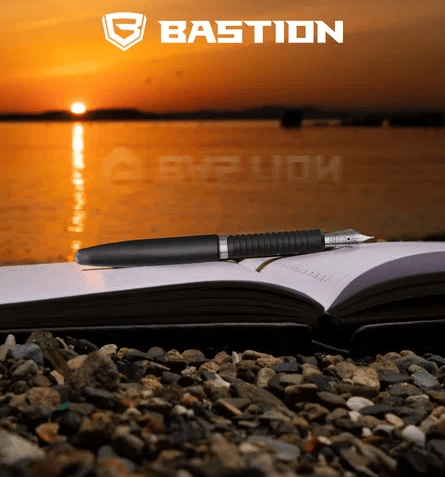
What is the Difference Between Ballpoint and Fountain Pens?
Mike NavitskyShare
For anyone who enjoys writing by hand, having the right EDC pen can make all the difference in the world. Two of the most popular types of pens are ballpoint and fountain pens, each with its unique features and benefits. In this blog post, we’ll take a close look at ballpoint and fountain pens, comparing and contrasting them so you can decide which might be best for your writing needs.
The Basics of Ballpoint Pens
Ballpoint pens contain, as their name suggests, a small metal ball at the tip that rotates to distribute ink onto the page. When you write, the ball rolls, picking up ink stored inside the pen and depositing it smoothly onto the paper. Ballpoint pens function via capillary action, where the ink essentially clings to the ball through surface tension. As the ball rotates and encounters paper, the ink transfers onto the page.
Popular ballpoint pens like the bolt action ballpoint pen deliver a smooth writing experience. The bolt action mechanism allows you to extend and retract the pen tip easily. This prevents drying out and creates a fidget-friendly pen for quick writing sessions. Ballpoints like this are a versatile option for everyday carry.

The Draw of Fountain Pens
Fountain pens operate quite differently than ballpoints. They contain a reservoir or cartridge which holds liquid ink. At the nib, or tip, of the pen, the ink is drawn out through capillary action, where it mixes with air on the way to the paper. This gives fountain pen ink a feathering effect for smooth, elegant lines.
Fountain pens allow for more control and pressure variation compared to ballpoints. With practice, you can achieve thin upstrokes and thick downstrokes by adjusting how you hold the pen. The ink flow responds to subtle movements, giving your writing natural character.
An EDC fountain pen like the Bastion makes an excellent starter fountain pen. With a sturdy body, snap-on cap, and replaceable nibs, it can handle everyday carry while letting you experience the joy of writing with a fountain pen. The ink cartridges make it simple to get started. Once you get hooked, you can move on to bottled inks and expand your color selection.
Key Differences Between Ballpoint and Fountain Pens
Now that we’ve covered the basics of each type, let’s summarize some of the key differences between ballpoint and fountain pens:

Ink Type and Writing Feel
Ballpoints use oil-based ink, while fountain pens use water-based ink. The ink chemistry affects drying time and versatility. Fountain pens offer more line variation and a gliding writing feel. Ballpoints have more resistance and consistency.
Maintenance and Ink Colors
Ballpoints are lower maintenance, while fountain pens require cleaning to prevent clogs. Fountain pen inks come in a wide spectrum of colors, while ballpoint colors are more limited.
Cost and Messiness
Good fountain pens tend to cost more than ballpoints. But everyday ballpoint models can be very affordable. Fountain pens tend to have a higher learning curve to avoid messes and smudges. Ballpoints are less prone to leaking.
Environmental Impact
Bottled fountain pen inks generate more plastic waste. Ballpoints use small pre-filled cartridges. Though the environmental impact of plastic cartridges is negligible still it exists and leads to waste generation making ballpoint pen the environmentally conscious choice.
As you can see, ballpoints and fountain pens each have their pros and cons. Choosing between them depends a lot on your specific needs and preferences as a writer.
Best Uses for Ballpoint vs. Fountain Pens
With their unique characteristics in mind, let’s look at what writing tasks ballpoint and fountain pens are best suited for.
Ballpoint Pens Tend to Excel When
- You need to write quickly, like taking notes or jotting down ideas.
- The ink flows instantly and you are writing for long periods.
- Their low-maintenance design prevents interruptions and you desire minimal smudging.
- The quick-drying ink prevents messy fingers and You are writing on cheap or absorbent paper.
- The thick oil-based ink won’t feather. Ballpoints require no pressure adjustments so you don’t want to worry about pressure.
Fountain Pens Excel When
- You want to add creative flair to your writing.
- The nibs and ink offer more expressiveness and you want to enjoy the process of writing.
- Fountain pens provide a smooth and elegant feel and you want to write frequently in short bursts.
- The nib stays moist and starts instantly and you want personalized line variation.
- Fountain pens respond to pressure changes and You wish to write with one pen forever. Many are durable and designed for longevity.
As you can see, ballpoint pens are ideal for quick, convenient writing tasks, while fountain pens offer more artistry and are the perfect pen for your handwriting. But there’s also quite a bit of overlap! Both pen types can effectively take notes, draft writing, sign documents, and more. It comes down to trying out different options to see what fits your preferences.
Conclusion
With their vastly different ink delivery methods, ballpoint and fountain pens each imparts a unique feel to the writing experience. Ballpoints excel at convenient, mess-free writing. Fountain pens add creative flair and writing enjoyment. As you determine what writing purpose you need to fulfill, you can decide whether the controlled glide of a fountain pen or the quick reliability of a ballpoint better suits your needs. And of course, you can always have both on hand! The best writing experience comes when you have the right pen for the situation.
